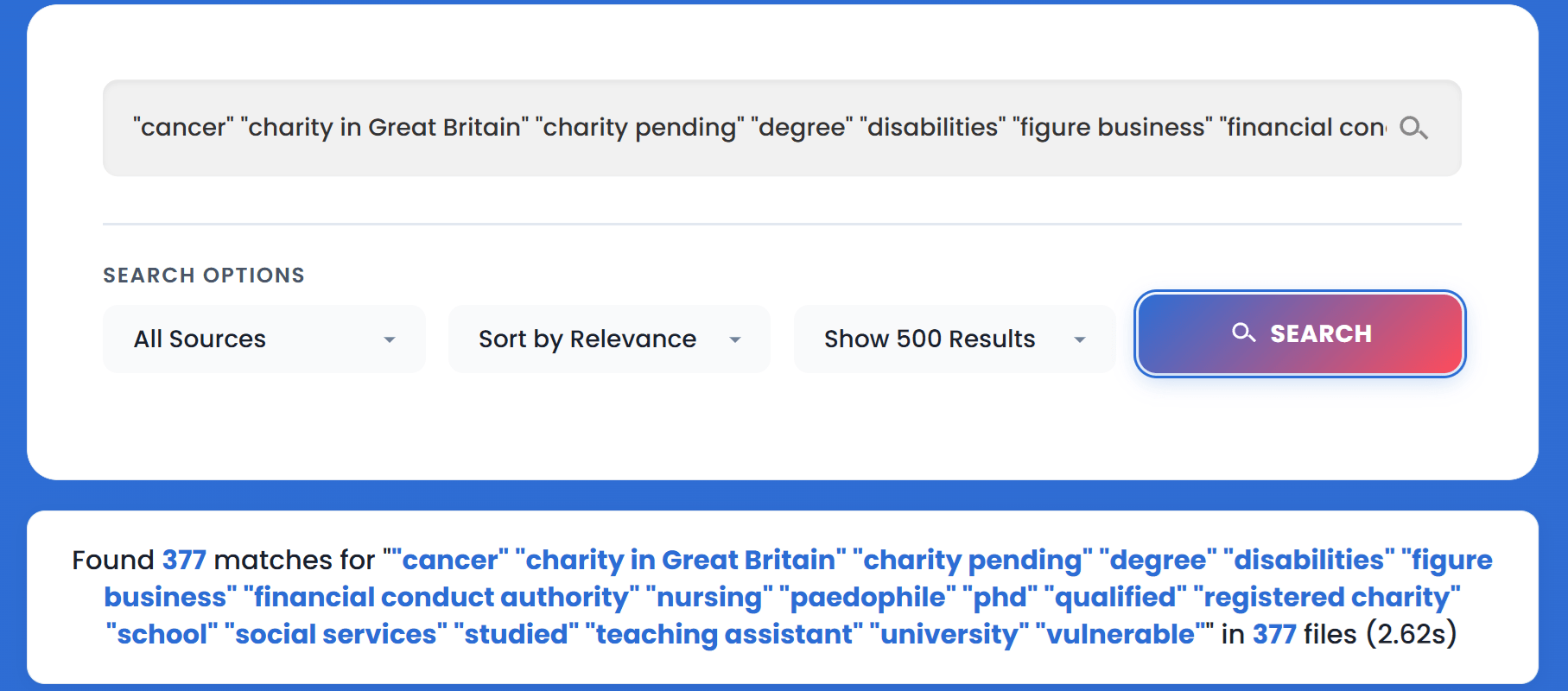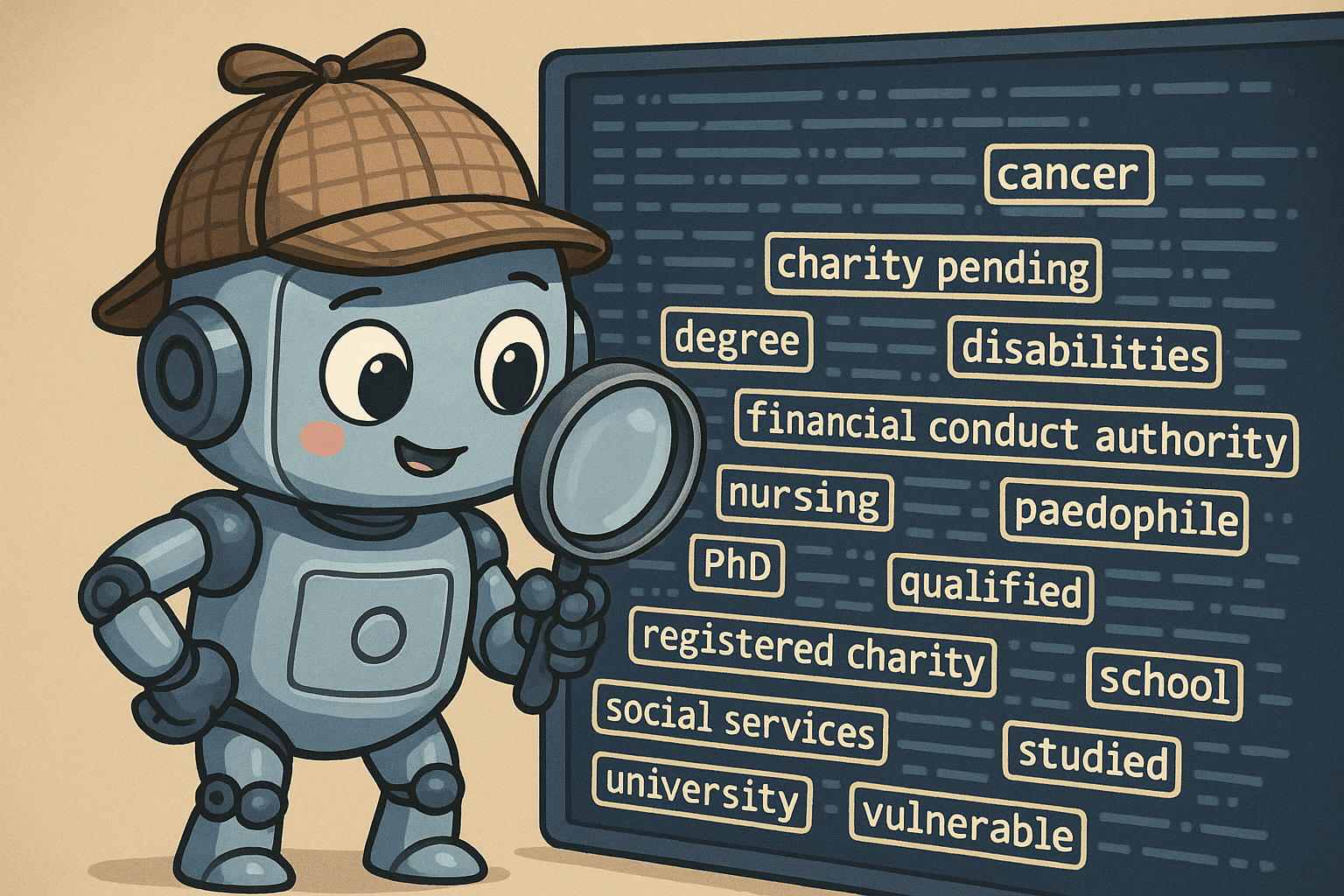Ever wondered how to test the truth of bold claims made by Jayne’s Baby Bank? At Sherlock’s “Flying Monkey” show we’ll pull back the curtain and demonstrate exactly how it’s done. Using a custom transcript search engine paired with modern AI (our ever-reliable Mr GPT), we’ll walk through the process of large-scale fact-checking in action. The approach isn’t limited to this case either — the same method can be applied to cut through hype and misinformation in everyday life.
Searching the transcript engine
If we head over to our transcript engine and use the search keywords below, we will receive a large output of information related to those terms. The more keywords we add, the larger the output. It is worth noting that quotes may also include background sounds, such as music, in addition to spoken statements from Jayne’s Baby Bank.

“cancer” “charity in Great Britain” “charity pending” “degree” “disabilities” “figure business” “financial conduct authority” “nursing” “paedophile” “phd” “qualified” “registered charity” “school” “social services” “studied” “teaching assistant” “university” “vulnerable”
Building a prompt
A good outcome depends on the “prompt” given to the AI. A prompt is a set of instructions that guide the AI’s analysis. A strong prompt produces useful results; a poor prompt produces poor results. Here is a guideline you can follow:
Prioritise contradictions across the transcripts, focusing on cases where Jayne’s Baby Bank presents conflicting or inconsistent statements about topics such as “cancer,” “charity in Great Britain,” “charity pending,” “degree,” “disabilities,” “figure business,” “financial conduct authority,” “nursing,” “paedophile,” “phd,” “qualified,” “registered charity,” “school,” “social services,” “studied,” “teaching assistant,” “university,” and “vulnerable.” Transcripts are the primary evidence, but PDF/image attachments must be used where they directly confirm or rebut a claim (for example, if the organisation states it was a teacher, the Education Workforce Council database in ewc.wales.pdf showing no registration must be cited as a counterpoint). Where no external evidence exists, identify internal contradictions (e.g. aplastic anaemia described both as cancer and not cancer). When dates are absent, use filename, page/line reference, or keyword context for precise citation. All claims must be attributed impersonally as organisational statements (“the organisation states…”, “the organisation presents itself as…”). For each contradiction, extract and quote the original statements verbatim with references, reframe into a clear contradiction finding, provide a counterpoint either from attachments or transcript logic, add commentary explaining why the contradiction is misleading or hypocritical, and state implications for donors, beneficiaries, and regulators. The report should include an executive summary highlighting key contradiction themes, a minimum of 15 contradiction findings in full detail, and a conclusion summarising the overall risks. Reports must remain neutral, factual, public-facing, and written in plain British English with minimal jargon, while always stressing why contradictions matter for credibility and public trust.
** PLEASE REPLY WHEN YOU’RE READY FOR US TO SUBMIT THE TRANSCRIPTS **

ChatGPT
ChatGPT is an AI system with wide-ranging applications. It can write, edit, create, and analyse content from any given instruction. By using the above prompt and our initial search results (by copying all content output with a result limit of 500 into the AI when requested), we can produce a datasheet (fact-check) showing whether or not there are conflicting claims or concerns. To strengthen the findings, we can also attach documentation from our archive as a reference source, as noted in the prompt above. In our testing, we converted PDF files into PNG format for easier processing due to technical limitations.
Result
Executive Summary
Recurring contradictions concern status and regulation (“registered charity”, “regulated by councils/FCA”), professional claims (nursing, teaching, PhD/degree), safeguarding and referrals (social services, DBS, “qualified”), and health claims (“cancer”, “vulnerable adult under the Cancer Act”). Councils, regulators, and independent organisations have refuted or qualified multiple self-descriptions and implied authorities. These inconsistencies erode credibility, create safeguarding risk, and mislead donors and beneficiaries about oversight and protections.
Contradiction Findings
- Registered charity vs not a registered charity
Transcript A: “we are a not-for-profit entity, even though we’re not a registered charity.” (Facebook Video)
Transcript B: “registered charity… she runs a registered charity.” / “we’re not even a registered charity.” (Facebook Video)
Counterpoint: Trading Standards recorded a poster in the shop window stating “charity” and requested removal.
Commentary: Messaging alternates between disavowing charity status and presenting as a charity.
Implications: Donors may assume charity oversight that does not exist. - “Registered with 3 councils” vs councils’ denials
Transcript: “We are registered by 3 councils… authorised by 3 councils to trade and operate in Wales.” (Facebook Posts)
Counterpoint: Caerphilly Council states it does not support the organisation and directs complainants to the Fundraising Regulator.
Commentary: “Authorised” and “registered” are asserted broadly; council email denies support.
Implications: Misrepresentation of council endorsement misleads the public and partners. - Social services referrals: do and don’t
Transcript A: “We do not make social services referrals unless it is absolutely necessary… self-referral.” (Facebook Post)
Transcript B: “By law, they have to tag in social services… I am qualified and experienced to allow that to happen.” (Facebook Video)
Counterpoint: Social Services confirm the organisation is not endorsed and not allowed to make referrals on its behalf.
Commentary: Claims of referral authority conflict with council statement.
Implications: Safeguarding confusion and potential risk to families seeking help. - FCA “authorisation” and regulation
Transcript A: “authorised by the Financial Conduct Authority to use our sensitive business name…” (Facebook Video)
Transcript B: “Only financial conduct authority approved charity.” (Facebook Video)
Counterpoint: The Fundraising Regulator confirms the organisation is not registered; the FCA does not regulate charities’ activities.
Commentary: Conflates name-use or business processes with regulatory oversight.
Implications: Public may wrongly believe an external regulator supervises fundraising. - Trussell Trust association
Transcript: “Distributes food supplied by the Trussell Trust…” (Staff note)
Counterpoint: The Trussell Trust confirms Jayne’s Baby Bank is not a Trussell foodbank.
Commentary: Stated association is contradicted by Trussell.
Implications: Risk of misleading donors about supply chains and standards. - “Registered foodbank/baby bank” vs status
Transcript: “We are a regsiteted baby bank and child foodbank with Caerphilly and Torfean Council and the Financial Conduct Authority.” (Facebook Post)
Counterpoint: The council denies support or endorsement.
Commentary: No corroborating register exists.
Implications: False assurance of compliance and oversight. - Food-business form declares “A charity… charity number awaiting” vs repeated “not a registered charity”
Transcript: Multiple admissions of “not a registered charity.” (Facebook Videos/Posts)
Counterpoint: Food business registration lists operator type as “A charity… charity number Awaiting.”
Commentary: The application characterises the operator as a charity while public content disclaims charity status.
Implications: Inconsistent regulatory disclosures. - Cancer and “vulnerable adult under the Cancer Act” vs diagnostic uncertainty
Transcript A: “I am a registered vulnerable adult under the Cancer Act.” (Facebook Video)
Transcript B: “But they didn’t see any cancer in the bowel from the CT scan.” / “Aplastic Anemia isn’t bone marrow cancer.” (Facebook Videos/Posts)
Counterpoint: No statutory “Cancer Act registration” exists.
Commentary: Presents incompatible health assertions.
Implications: Appeals to vulnerability may be overstated. - Nursing status: qualified practitioner vs student
Transcript A: “I am a qualified healthcare professional.” (Facebook Video)
Transcript B: “When I was training to be a nurse at Cardiff University…” (Facebook Post)
Counterpoint: No NMC registration evidence.
Commentary: Alternates between student experience and qualified professional status.
Implications: Public may rely on non-existent qualifications. - Teaching claims vs EWC record
Transcript: “Worked… as a teaching assistant for 12 years.” (Facebook Post)
Counterpoint: The Education Workforce Council confirms no registration.
Commentary: Persistent presentation of roles vs regulator showing no registration.
Implications: Safeguarding credibility impact. - “PhD in biochem” vs “diploma in biochem”
Transcript A: “I’ve got a PhD in biochem.” (Facebook Video)
Transcript B: “I did a diploma in biochem to get in.” (Facebook Video)
Counterpoint: Internal contradiction.
Commentary: Degree inflation suggests misrepresentation.
Implications: Trust risk. - “Qualified” authority vs refusal of social worker involvement
Transcript A: “I am a qualified health practitioner… I can make the decision if Mothers need help.” (Facebook Post)
Transcript B: “Please don’t contact us… if you are a social worker. I won’t help you.” (Facebook Post)
Counterpoint: Council confirms no referral authority.
Commentary: Claims discretion while rejecting statutory professionals.
Implications: Safeguarding risk. - “Regulated by Fundraising Regulator/FCA” vs not registered
Transcript: “regulated by… Financial Conduct Authority.” (Facebook Post)
Counterpoint: The Fundraising Regulator confirms not registered.
Commentary: Uses “regulated by” without basis.
Implications: Misleading assurance. - “Registered foodbank in two counties” vs council position
Transcript: “We are a registered foodbank in two counties.” (Facebook Post)
Counterpoint: The council denies support.
Commentary: Term “registered” appears self-assigned.
Implications: Misleading. - “Charity pending” trustees and assets vs “owner of the charity”
Transcript A: “trustees of our charity pending will decide…” (Facebook Post)
Transcript B: “the trustee of the charity… and the owner of the charity.” (Facebook Video)
Counterpoint: No such concept as “owner of a charity” in UK law.
Commentary: Governance language conflicts with norms.
Implications: Donor confusion over accountability. - Council and police “backing” vs written cautions
Transcript: “we have the backing of the councils and the police.” (Facebook Post)
Counterpoint: The council distances itself; Trading Standards required removal of “charity” sign.
Commentary: “Backing” contradicted by documentary record.
Implications: Overstated legitimacy. - “Largest baby bank in Wales” vs early-stage registration
Transcript: “WE are the largest Baby Bank in the Wales.” (Facebook Post)
Counterpoint: No evidential basis; simultaneous claims of “preliminary numbers.”
Commentary: Market-leading claim unverified.
Implications: Misleading marketing. - “Qualified baby bank” vs no qualification standard
Transcript: “Jayne’s Baby Bank is a qualified baby bank.” (Facebook Post)
Counterpoint: No recognised UK qualification for baby banks.
Commentary: Professionalised terminology without standard.
Implications: False sense of safety. - “Registered vulnerable adult under the Cancer Act” vs undefined scheme
Transcript: “I am a registered vulnerable adult under the Cancer Act.” (Facebook Video)
Counterpoint: No such registration scheme identified.
Commentary: Legalistic framing without basis.
Implications: Appeals to special protection to deter criticism. - “Council-recognised training” vs EWC/NMC absence
Transcript: Claims of Cardiff University training, safeguarding training, clinical scope. (Facebook Posts)
Counterpoint: Not registered with relevant regulators; council denies support.
Commentary: Professional aura built on anecdotes rather than verifiable registration.
Implications: Safeguarding and consumer-protection risk.
Conclusion and Risk Summary
The materials show repeated shifts between being a non-charity and presenting as a charity; between regulatory “registration/authorisation” and documentary denials; and between student experience and “qualified” professional status. Councils and regulators cited either distance themselves or confirm non-registration. These contradictions matter because they:
- Mislead donors about oversight, complaint routes, and use of funds.
- Create safeguarding ambiguity for vulnerable families, volunteers, and children.
- Expose beneficiaries and the public to unmanaged risk where professional status is asserted but unverified.
- Sherlock🕵️
